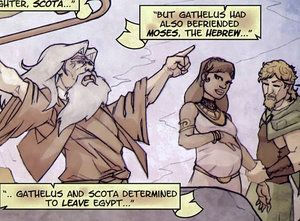Difference between revisions of "Moses"
m (→History) |
|||
| Line 6: | Line 6: | ||
Moses had befriended [[Gathelus]] and [[Scota]] and had warned them of the plagues that would befall the kingdom of [[Egypt]]. When Gathelus and Scota left Egypt, Moses entrusted them with [[Stone of Destiny|Jacob's Pillow]], the Hebrews' sacred stone. ''("[[The Rock]]")'' | Moses had befriended [[Gathelus]] and [[Scota]] and had warned them of the plagues that would befall the kingdom of [[Egypt]]. When Gathelus and Scota left Egypt, Moses entrusted them with [[Stone of Destiny|Jacob's Pillow]], the Hebrews' sacred stone. ''("[[The Rock]]")'' | ||
| − | An alternate version of the Stone of Destiny's history claims that Moses took the Stone with him when he led the Hebrews out of Egypt, and that it was the very stone he struck to supply them with water when they became thirsty ''("[[Rock and Roll|Rock & Roll]]")''. It is as yet unknown which of these two accounts is true in the | + | An alternate version of the Stone of Destiny's history claims that Moses took the Stone with him when he led the Hebrews out of Egypt, and that it was the very stone he struck to supply them with water when they became thirsty ''("[[Rock and Roll|Rock & Roll]]")''. It is as yet unknown which of these two accounts is true in the Gargoyles Universe. |
==Appearances== | ==Appearances== | ||
Revision as of 15:21, 9 April 2009
Moses was a Hebrew prophet in ancient times.
History
Moses had befriended Gathelus and Scota and had warned them of the plagues that would befall the kingdom of Egypt. When Gathelus and Scota left Egypt, Moses entrusted them with Jacob's Pillow, the Hebrews' sacred stone. ("The Rock")
An alternate version of the Stone of Destiny's history claims that Moses took the Stone with him when he led the Hebrews out of Egypt, and that it was the very stone he struck to supply them with water when they became thirsty ("Rock & Roll"). It is as yet unknown which of these two accounts is true in the Gargoyles Universe.
Appearances
- "The Rock" (First Appearance, No Lines)
- "Rock & Roll" (No Lines)
Real World History
One of the best-known figures of the Old Testament, Moses was the son of a Hebrew couple dwelling in ancient Egypt. The Pharaoh of that time, afraid that the Hebrews might assist foreign enemies in conquering Egypt, had decreed that all male Hebrew infants be put to death; to protect their son from this fate, Moses' parents placed him in an ark made of bulrushes and floated him down the Nile, where he was discovered by Pharaoh's daughter, who adopted him. When Moses grew up, he slew an Egyptian overseer for beating a Hebrew and was forced to flee into exile in Midian as soon as his act became known. Many years later, God sent Moses back to bid the new Pharaoh (the original Pharaoh had died during this time) set the Hebrews free; when Pharaoh refused, Moses called down ten plagues upon Egypt. After the tenth of these (the deaths of all the first-born sons of the Egyptians), Pharaoh relented and let the Hebrews leave Egypt; afterwards, he regretted this decision and pursued them, cornering them at the Red Sea. At God's bidding, Moses parted the Red Sea, allowing the Hebrews to cross safely to the other side; the Red Sea closed behind them, drowning Pharaoh and his army. Afterwards, Moses received the Ten Commandments from God atop Mount Sinai, as well as the rest of the Hebrew Law. Moses led the Hebrews through the wilderness for the next forty years, finally dying atop Mount Nebo just before they entered Israel.
See also
- Moses at Wikipedia, the Free Encyclopedia
